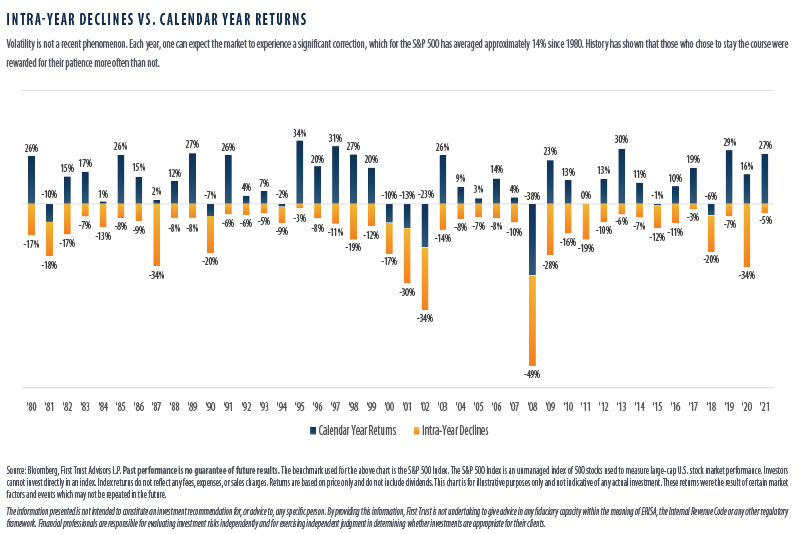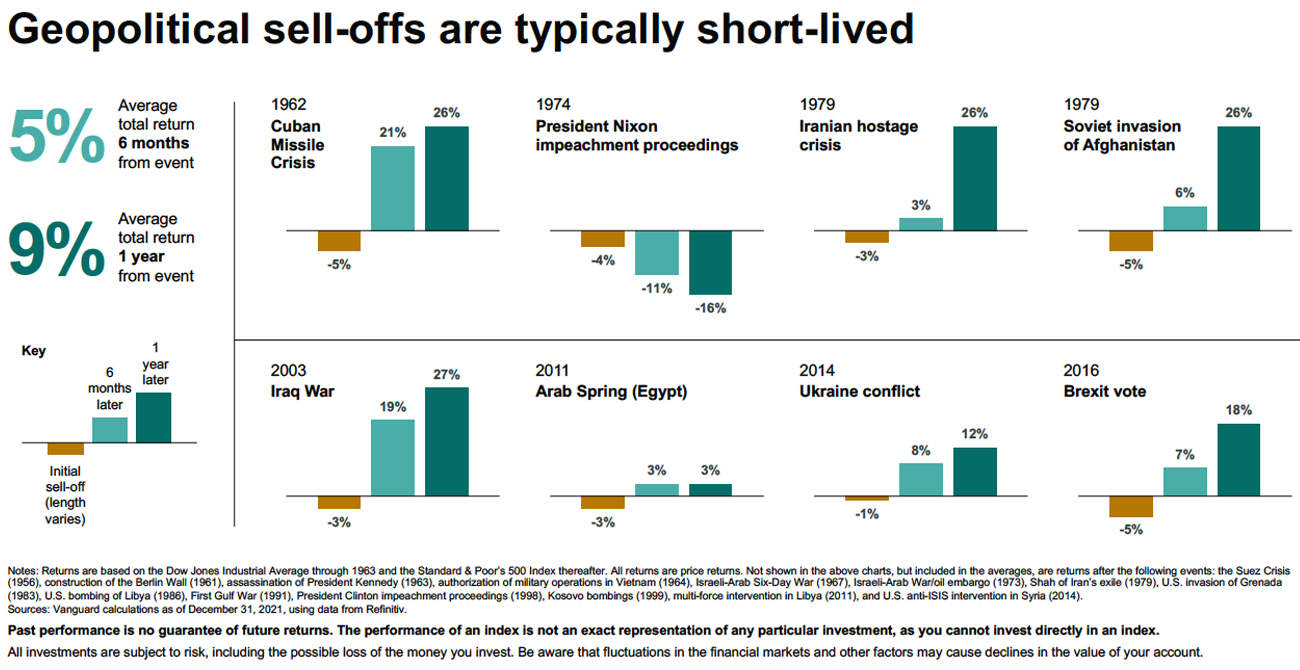After a difficult start to 2022, February has certainly been a challenging month and the markets (S&P 500) have officially entered “correction” territory with Russia’s invasion of Ukraine. A correction is defined as a drop of 10% from its peak and is far from uncommon. While we’ve experienced seven since 2000, they are still nerve-wracking nevertheless.
There’s an ever-changing list of things that can possibly impact the markets. As we’re moving past the worry of COVID and Omicron (at least for now), there are always new worries on the horizon. It’s nothing new and, unfortunately, will always be the case. I’ve compiled a list of issues the markets are reacting to now – another reminder that the markets “climb a wall of worry.”
- Russia invading Ukraine
- Inflation at its highest level in 40 years
- Growth stocks crashing
- Fed announces that they will begin tightening monetary policy and increasing short-term interest rates
- Labor market and supply chain shortages
- Perhaps the craziest housing market in history
- Oil prices hitting $100/barrel (again)
By the time you’re reading this, there could easily be one or two more “worries” added to the list.
History has shown us time and time again that reacting to the scary headlines and liquidating stock positions amid a market downturn or correction is almost always the wrong move. Look no further than the markets on Thursday, February 24, the day after Russia invaded Ukraine. The market was down well over 2% for most of the day, and then surprisingly reversed course in the middle of the day and finished up more than 1%. It’s understandable that many had anxiety and perhaps even panicked that morning, which is totally natural. I know I didn’t sleep very well when I saw the news of the invasion the night before. When the markets fluctuate, it helps me to gain perspective by looking at prior events and studying the way the markets tend to behave and react. Intuitively, I know the prudent thing to do is remain committed to our plan and not react by selling during a moment of panic. It’s not always easy. History tells us to remain patient, but the events that generate the downturns are always a bit unique and that naturally creates a sense of uncertainty. I find the below visuals helpful as they provide some much-needed perspective.


I remember one of Larry Grabenstein’s favorite sayings when comparing the events of today and the market’s reactions to historic events: “I look at teenage boys today and the stupid things they tend to do, and while the stupid things they do today may be different than the stupid things that we did as teenagers, hormones are still hormones.” While we deal with current events and unsettling headlines, it’s easy to say, “Well, this time it’s different. This time it’s going to be much worse than it was before.” I understand that thinking. However, we’re still dealing with the underlying emotions of fear, hope and greed that drive the market through its cycles: that part will likely never change. The investors that remain rational and maintain their patience and discipline throughout the market’s ups and downs are those that are most likely to succeed and achieve their desired outcomes.
If you missed the recent Raymond James webinar, Russia and Ukraine on the Edge: Geopolitics, Oil and the Equity Markets, we invite you to watch by clicking this link. It’s worth viewing (about 52 minutes) and has been the most well-received Raymond James webinar we’ve ever shared.
As always, please do not hesitate to reach out if you have any questions or concerns. That’s why we’re here.
Take care,
Todd M. Wike, CFP®
CERTIFIED FINANCIAL PLANNER™
Managing Partner, Potomac Financial Group
2022 RJFS Chairman’s Council Member*
TSource: Trust Portfolios L.P., www. ftportfolios.com and Vanguard
The information contained in this material does not purport to be a complete description of the securities, markets, or developments referred to in this material. The information has been obtained from sources considered to be reliable, but we do not guarantee that the foregoing material is accurate or complete. Any opinions are those of Todd Wike and not necessarily those of Raymond James. Expressions of opinion are as of this date and are subject to change without notice. There is no guarantee that these statements, opinions or forecasts provided herein will prove to be correct. Investing involves risk and you may incur a profit or loss regardless of strategy selected. Keep in mind that individuals cannot invest directly in any index, and index performance does not include transaction costs or other fees, which will affect actual investment performance. Individual investor’s results will vary. Past performance does not guarantee future results. Future investment performance cannot be guaranteed, investment yields will fluctuate with market conditions. Raymond James is not affiliated with and does not endorse the services or opinions of the various podcasts or applications discussed in this material. Chairman’s Council Membership is based on prior fiscal year production. Re-qualification is required annually. The ranking may not be representative of any one client’s experience, is not an endorsement, and is not indicative of advisors future performance. No fee is paid in exchange for this award/rating. Certified Financial Planner Board of Standards Inc. owns the certification marks CFP®,CERTIFIED FINANCIAL PLANNER™, CFP® (with plaque design) and CFP® (with flame design) in the U.S., which it awards to individuals who successfully complete CFP Board’s initial and ongoing certification requirements.

